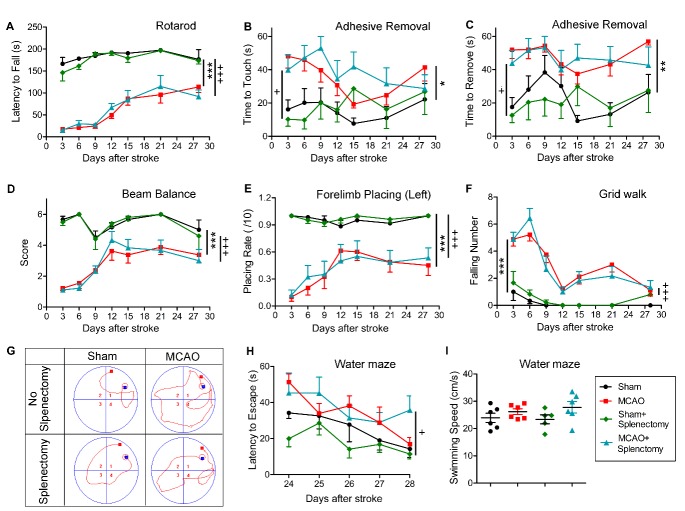Figure 2.
Delayed splenectomy after ischemic stroke failed to improve long-term neurological functions. Rats were exposed to 90 min of MCAO, followed by splenectomy or mock surgery right upon reperfusion as described in Materials and Methods. Sham-operated rats with or without splenectomy were used as control. All rats were allowed to survive for 28 days. (A) Rotarod test. The latency to fall off Rotarod was recoded. (B-C) The adhesive removal test. The time to touch (B) and the time to remove the tapes (C) were recorded. (D) Beam balance test. The performance on beam was scored 1-6. (E) The forelimb placing test on left (lesion side) forelimb. The number of successful placing out of 10 trials was recorded. (F) The grid walk test was assessed by counting the number of forelimb falling. (A-F) n=6 rats for sham groups; n=9 rats for MCAO groups. (G-I) Learning ability was examined by the Morris water maze test at 24-29 days after MCAO. n=5-6 rats per group. (G) Representative images of the swim paths at 28 days after MCAO (H) Latency to locate the submerged platform at 23-28 days after MCAO. (I) Swim speed at 28 days after MCAO. Values are mean ± SEM. Sham vs MCAO group: *p ≤ 0.05, **p ≤ 0.01, ***p ≤ 0.001 by two-way ANOVA repeated measurements. Sham+Splenectomy vs MCAO+Splenectomy group: +p ≤ 0.05, +++p ≤ 0.001 by two-way ANOVA repeated measurements.

